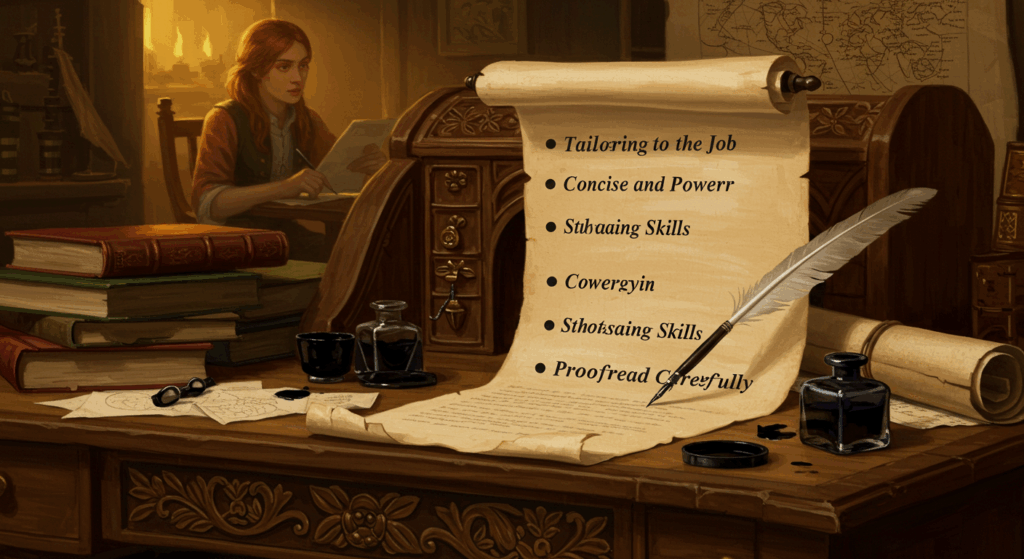You see, if résumés are the neatly curated Spotify playlists of your work life, cover letters are the voice notes you send to your friend at 2 a.m. explaining the vibe behind each track. They give context. They add personality. And, they connect dots that might look random on paper. And ngl, they can be the difference between “we’ll pass” and “let’s get them on a call.”
If you’ve ever googled “What is a cover letter?” at 11:59 p.m. with a deadline looming, hi. Same. This guide breaks things down in a low-stress, chatty way—like we’re on the couch scrolling Netflix previews and you’re asking, “Wait, do I really need this thing?” Short answer: usually, yes. Longer answer: keep reading.
I’ll hit the definition, the importance, and the real-world usage of cover letters (yep, those exact keywords, because SEO but make it chill). I’ll also share practical tips, mini templates, common mistakes, and a few “I learned this the hard way” moments, so you don’t have to.
So, What is a Cover Letter? Actually
At its simplest, a cover letter is a short, customized message that covers your résumé. It explains why you’re applying, how your experience connects to the role, and what you’ll contribute if hired. Think of it as the opening scene of a movie that sets the tone before the main story (your résumé) starts rolling.
A clean definition you can steal:
A cover letter is a concise, tailored note that accompanies a résumé to introduce the candidate, highlight relevant achievements, and connect their skills to a specific role at a specific company.
No fluff. No autobiography. Also, No “since I was five I’ve loved spreadsheets” (unless… you truly did?). It’s a story-driven pitch: why you + why this role + why this company + why now.
The Importance of a Cover Letter (Yes, in 2025 too)
Is a cover letter always required? Not always. Is it still valuable? Straight up: yes. Here’s the importance in plain English:
- It separates you from the crowd. Most people use the same résumé across dozens of applications. A tailored letter shows effort—which reads as ownership and intent. Hiring managers mnotice that.
- It clarifies your narrative. Maybe you’re switching industries, returning from a break, or have a squiggly career path. Your cover letter becomes the bridge, tying together your story and your future goals.
- It focuses on impact, not just tasks. Résumés say what you did; cover letters can explain why it mattered—with bite-sized context that makes the numbers pop.
- It’s a trust test. Good writing = good thinking. Even a quick, clean letter signals that you can communicate. That matters in almost every job (yes, even engineering).
- It shows you understand the assignment. Referencing the company’s mission or product (like you’ve actually tried the app) proves you’re not just mass-applying. And yes, recruiters can tell.
Bottom line: the importance of a cover letter is not about formality—it’s about differentiation.
Real-World Usage: When and how to send a cover letter
Here’s the usage cheat-sheet:
- When it’s requested. Obviously. If an application says “attach a cover letter,” do it.
- When it’s optional. Still do it, unless the posting explicitly says do not send. Optional is basically “impress me if you care.”
- When you’re changing lanes. Career switchers, students, parents returning to work, freelancers going in-house—this is your storytelling tool.
- When you have a referral. “Jane in Product recommended I reach out”—boom, instant context and credibility.
- When you have unique value. Maybe you’re a power user of their tool, you’ve run a similar growth playbook, or you’ve solved the exact problem they mention in the job post.
- Email vs. attachment? If the application portal has a field for “cover letter,” upload a PDF. If you’re emailing someone directly, the email body can be your cover letter (shorter is better).
Pro tip: Spend 15–20 minutes customizing for each application. You can build a reusable base, but always tweak the intro, a key story, and the closing to match the role and company. That’s efficient usage, not busywork.
How a Cover Letter Plays with Your Résumé
Think of the résumé as your highlight reel: titles, dates, metrics. Your cover letter is the director’s commentary. It should:
- Pick one or two relevant wins and expand with quick context. Not a recap of your whole résumé.
- Mirror the job description’s language (without sounding like a robot). If they say “customer-obsessed,” show a sentence that proves you are.
- Lead with outcomes. Not “I was responsible for” but “I launched X that led to Y.”
- Show you get the business. Mention their product, users, or strategy—briefly. Keep it real, not stalkerish.
Anatomy of a Strong Cover Letter (easy mode)
Here’s a repeatable structure that works across roles:
- Header
Your name, email, phone, LinkedIn/portfolio. (If emailing directly, a simple signature works.) - Greeting
“Hi [Name],” or “Dear [Hiring Manager],” (First names are okay if the company vibe is casual.) - Hook (1–2 sentences)
A punchy line that connects you + the role + the company. If you can include a quick metric, chef’s kiss. - Relevance (1 short paragraph)
2–3 bullets or sentences linking your top wins to the job requiements. Make it obvious you can do this job. - Proof of Alignment (1 short paragraph)
Show you understand their product/mission/market. Bonus points for a concise insight or suggestion (respectful, not “I know better than you”). - Close (2–3 sentences)
Recap the value, express genuine interest, and give a call-to-action (an interview, chat, or review of your portfolio).
Aim for ~250–400 words. If it’s longer than a dating app bio that overshares five dogs and three exes… it’s too long.
Types of Cover Letters You’ll Actually Use
Application Cover Letter
The classic. You’re applying to a posted role with a clear job description.
Referral Cover Letter
You mention the person who referred you in the first sentence. Keep it gracious: “I was excited to apply to [Role] after speaking with [Name] on [Team].”
Cold Cover Letter
You’re reaching out when there’s no posted job. Keep it crisp, show relevant wins, and propose how you can add value.
Internal Cover Letter
Applying within your company? Emphasize your cross-team wins and how you’ll ramp faster than an external hire.
Email Cover Letter (Short Form)
When sending directly to a recruiter/hiring manager. Keep it to ~150–250 words. Attach résumé and portfolio links.
The Definition, Importance, Usage… but with Examples
A quick “definition” in action
“I’m a lifecycle marketer who scaled onboarding emails for a B2C app to +28% activation. I’m applying to the Lifecycle Marketing Manager role at Loop because your focus on habit-building aligns with how I think about retention.”
See? That’s the definition in motion: brief, customized, relevant.
Showing “importance” without sounding extra
“I noticed your job post prioritizes onboarding and churn reduction. I’ve led two activation experiments that raised Day-7 retention by 12%—happy to share the playbook and what didn’t work.”
It proves the importance of sending a letter: it spotlights your best match-ups to the job’s needs.
Demonstrating “usage” like a pro
“I’m including a 3-sentence case snapshot below to show how I’d approach your ‘first 90 days’ onboarding goal.”
That’s practical usage—giving them a taste of your process, not just fluff.
The 3-Line Formula (when you’re rushing but still want it to slap)
- Line 1: Why them
“I’m applying for [Role] at [Company] because [specific product or mission detail] genuinely excites me.” - Line 2: Why you
“In my last role, I [impact metric] by doing [action], which maps directly to your need for [requirement from job post].” - Line 3: What next
“I’d love to share a quick walkthrough—could we set up a short call next week?”
Short. Respectful. Targeted. You can paste this in an email or turn it into the opening and closing of a longer letter.
A Few Mini Templates You Can Steal (and edit)
Product/Marketing Hybrid
Hi [Name],
I’m applying for the [Role] on [Team]. I’ve been a daily user of [Company/Product] for [timeframe], and I’m genuinely impressed by [specific feature or recent launch]. That focus on [user outcome] is exactly where I’ve been strongest.
At [Previous Company], I led [project] that grew [metric] by [X%]. The playbook combined [strategy 1] + [strategy 2] and included experiments like [one sentence]. I see parallels in your job post around [requirement], and I’d be excited to bring that approach to [Company].
I’m attaching a short case study with before/after metrics. Thanks for considering—would love to chat.
Best,
[You]
Early-Career / First Job
Dear Hiring Manager,
I’m a recent grad in [major] who interned at [Company/Project], where I shipped [result]. I’m applying for [Role] at [Company] because your work on [mission/product] hits home. I’ve attached a portfolio with [two highlights], and I’m comfortable learning quickly—especially in [tool/skill].
I’d love to contribute to [specific team goal] and grow with the team. Thanks for your time.
Sincerely,
[You]
Engineering (Concise)
Hi [Name],
I’m a full-stack engineer (React, Node, Typescript) who built [project] that handled [scale/metric]. I’m applying to [Role] because your roadmap around [tech or product] is exactly where I’m strongest. I value clean code, tests, and thoughtful DX—happy to share a repo or walk through system design.
Best,
[You]
Operations / Customer Success
Hello [Name],
Your focus on customer-led growth is my jam. At [Previous Company], I owned a book of [X] accounts and improved retention by [Y%] via [specific initiative]. I’m applying for [Role] at [Company] because your users’ feedback around [issue/opportunity] lines up with the playbooks I’ve used (health scores, quarterly business reviews, and proactive risk flags).
Thanks for your consideration—open to a quick intro call anytime this week.
Best,
[You]
The Vibe: Tone, voice, and being yourself (without over-sharing)
You don’t have to write like a legal document. You also don’t need to write like a TikTok caption. The sweet spot is: professional, warm, and specific. A few rules of thumb:
- Write how you’d speak in a first interview. Friendly, clear, no slang that could confuse.
- Short sentences win. If you need to take a breath while reading, it’s too long.
- Replace adjectives with evidence. Not “I’m passionate,” but “I spent my weekends testing onboarding flows because I wanted to learn activation levers.”
- Never neg your past employer. Even if they deserved it—save it for brunch, not your cover letter.
Quick Guide to Personalization (without spending forever)
Use the 3-3-3 Method:
- 3 minutes skimming the job description—highlight the top 3 requirements.
- 3 minutes looking at the company’s product/press—note one insight, one question, one proof you care.
- 3 minutes editing your base template—customize the hook, one achievement, and the close.
You’ve now got targeted usage with minimal time sink. This beats “Dear Sir/Madam, to whom it may concern, I am writing…” every time.
Metrics: Your secret power move
Numbers anchor your story. They scream credibility. If you don’t have exact numbers, use ranges or proxies:
- “Increased click-through by ~12% over two sprints.”
- “Handled 40–60 support tickets/day while holding a 95% CSAT.”
- “Shipped 8 features in 6 months, reducing average page load by ~35%.”
- “Led onboarding for 15 new clients in Q1 with 100% go-live.”
Don’t force it, but try to include at least one metric. It makes everything feel real.
Common Myths (and what’s actually true)
- Myth: No one reads cover letters.
Truth: Some don’t; many do—especially hiring managers for top candidates. Your letter isn’t for everyone; it’s for the one person deciding whether to talk to you. - Myth: They have to be formal and stiff.
Truth: Professional ≠ robotic. Warm and clear beats verbose every time. - Myth: You must restate your entire résumé.
Truth: Pick 1–2 relevant wins, add context, and tie them to the role. Done. - Myth: If the portal has no “cover letter” field, don’t send one.
Truth: Use the “additional info” field, or include a few targeted paragraphs in the recruiter email.
Mistakes to Avoid (learn from my cringe)
- Generic openers. If your first line could apply to any job, you’re already behind.
- Company name typos. Double-check. Then triple-check. (Ask a friend. Bribe with snacks.)
- Wall-of-text formatting. Use short paragraphs, white space, maybe a few tasteful bullets.
- Focus on duties, not outcomes. “Owned the blog” says nothing. “Grew blog traffic 3×” says everything.
- Talking only about what you want. Yes, you want growth. Tell them what they get.
- Over-apologizing. “I know I don’t have X…” If you must, pivot to strengths fast and show how you’ll learn.
ATS, Keywords, and Keeping It Human
Applicant Tracking Systems (ATS) scan for keywords, but humans make decisions. The blend is key:
- Mirror the job description’s wording (lightly). If they say “lifecycle marketing,” don’t only write “email marketing.”
- Use role-specific nouns and verbs: “prospecting,” “pipeline,” “churn,” “DAU/MAU,” “retention,” “OKRs,” “unit tests,” “SLA.”
- Don’t keyword-stuff. It’s obvious and icky. Place terms where they naturally fit your story.
The “Definition, Importance, Usage” Recap (TL;DR, but friendly)
- Definition: A tailored note that translates your résumé into a compelling pitch for this role at this company—short, focused, and human.
- Importance: It differentiates you, explains your narrative, and proves you understand the company’s needs (and how you’ll meet them).
- Usage: Send it when requested, when optional (usually), when you’re changing paths, when you have a referral, or when you simply have a strong value story to share.
FAQ (because your brain is busy)
How long should a cover letter be?
About 250–400 words. Email versions can be 150–250 words.
PDF or Word?
PDF. Keep formatting clean and consistent.
Do I need a fancy design?
Nope. Crisp text, clean spacing, and a readable font beat wild formatting 100% of the time.
Can I use AI?
Use it to brainstorm structure or punch up clarity, but customize the content so it sounds like you. Add specifics no model could guess (your numbers, your projects, your insights). That’s what makes it real.
Do I repeat my résumé?
No. Think “highlight + context + outcome + why it matters to them.”
A Quick, Copy-Ready Checklist
- Strong hook connecting you to the company and role
- 1–2 specific wins with metrics (or solid proxies)
- Clear alignment with the job description’s top requirements
- One sentence showing you understand the product/mission/users
- Respectful, confident close with a call-to-action
- 0 typos in company name (pls)
- 300–400 words, max two short paragraphs + a few bullets if needed
- Saved as PDF (unless emailing directly)
Three Polished Openers You Can Customize Today
- “I’m applying for the [Role] at [Company] because your focus on [specific goal] is exactly where I’ve driven results—most recently lifting [metric] by [X%] at [Previous Company].”
- “As a daily user of [Product], I’ve admired how you [feature/outcome]. In my last role, I led [initiative] that [impact], and I’d love to bring that approach to [Team].”
- “After speaking with [Referral Name] about your roadmap for [thing], I’m ecited to apply for [Role]. I’ve shipped [relevant win], and I’m energized by the chance to help [Company] do [goal].”
Use these as a base, then add your details. That’s high-leverage usage in like… 60 seconds.
A Realistic Example (Mid-Level Marketing, ~300 words)
Hi Maya,
I’m applying for the Lifecycle Marketing Manager role at Hubble. I’ve been following your work on habit-building nudges (the new “Streak Saver” flow is clever), and I’m excited about your push to improve Day-7 retention.
At Orbit, I led onboarding experiments that increased activation by 28% in one quarter. The biggest lift came from a checklist + progressive profiling test that shortened time-to-value by 40 seconds and raised first-session conversion by 9%. I also built a lightweight segmentation framework to personalize nudges by user intent (learners vs. “quick win” folks), which dropped churn 12% over two sprints.
Your job post mentions event-based triggers, experimentation, and close collaboration with product/analytics. That’s my comfort zone. I write my own briefs, partner tightly with PMs and data to scope events, and keep tests small, fast, and reversible. I’ve worked in Iterable and Braze, and I’m happy in SQL for basic pulls.
What I appreciate about Hubble is the focus on helpful, non-spammy lifecycle moments—nudges that build trust, not just clicks. That’s my bar, too. I’m including a short case snapshot with screenshots and lift curves; happy to walk you through what didn’t work and how I’d approach your “first 90 days.”
Thanks for your time—would love to chat.
Best,
Ari
[LinkedIn] | [Portfolio]
Why it works: clear opener, relevant metrics, alignment with needs, respectful close. No fluff.
Final Thoughts (and a tiny pep talk)
If cover letters give you the ick, reframe the definition in your head: this isn’t a school essay. It’s your chance to make the first five seconds of attention count. The importance isn’t in tradition; it’s in your ability to translate your experience into business value quickly. And the usage isn’t complicated—hook, proof, alignment, close. That’s it.
You’ve got stories worth telling. Put them on the page with clarity and a bit of heart. Keep it short, show your receipts, and talk like a human. The right team will feel it.
Now go open that job post, pick one win you’re proud of, and write the first sentence. Then the next. You’re closer than you think. And hey—future you, walking into that interview? They say thanks.









